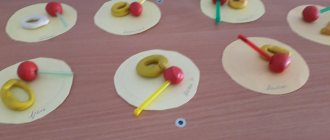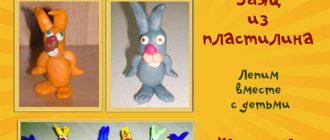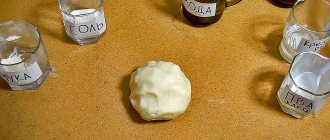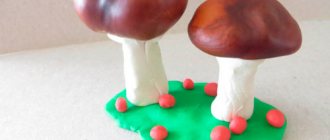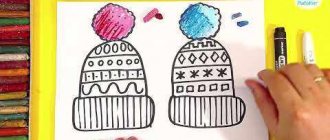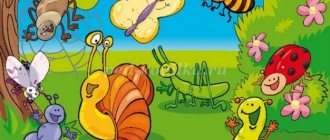Summary of an integrated lesson on native nature and modeling in the senior group - topic: “Snail”
Now you are no longer kids, you know that the snail does not understand your words and does not eat scones and pies. Today we will learn a lot of new and interesting things about the snail that you don’t know yet. Look at my snail exhibit. Each one has a question for you.
(photos of snails with questions)
1. What does a snail eat?
The snail is a herbivore. What does it mean? How do you understand the meaning of the word “herbivore”? Herbivore means one that eats grass and other plants. The snail eats the green foliage of various plants. On the snail's tongue, like on a file, there are hundreds of small teeth, with which the snail cuts and grinds food.
2. How does a snail live?
The snail is moisture-loving. What does moisture-loving mean? Listen carefully to this word and it will tell you its meaning. Moisture-loving - loves moisture. In dry weather, the snail hides under stones, in the shade of plants or in damp moss. Usually it spends the day hiding in its shell and comes out to feed at night. The snail is most active during the night and after a rainstorm.
In hot, dry summers, the snail becomes lethargic, inactive, and falls into torpor. During this period, the snail climbs into the shell and covers the exit with a thin transparent film. As soon as the rains come, she comes out of hibernation.
3. How does a snail winter?
In the fall, when it gets cool outside, snails bury themselves in the soil for the winter. In the spring, when it gets warmer, they awaken and leave their winter shelter.
4. Why does a snail need horns?
The snail does not have only antennae horns, but two pairs - two and two. One small pair is the antennae that the snail uses to sniff. The second large pair are eyes. The antennae horns of snails are very sensitive: if they accidentally touch any object, the snail immediately removes them inside. Remember this. Some children love to poke the snail and watch it hide its horns. Never do this! No one can like being poked in the eyes.
5. How does a snail move?
Have you watched a snail more than once? Do you think the snail moves fast or slow? Indeed, the snail moves very slowly. Let's all say the following words together: “Snail, crawl a little on your leg!” (Children say these words in chorus)
.
While we were talking, the snail managed to crawl this distance. (Showing a segment 1.5 cm long)
.
You may have wondered how a snail manages to crawl if it has no visible legs. The fact is that the entire lower part of the snail’s body is a solid “leg”! When a snail crawls, a sticky liquid flows out of its leg, which helps the snail move and stay on the surface:
Snails can crawl upside down
Because they are amazingly sticky.
6. Is the snail’s shell safe?
If the snail is disturbed, it hides in its shell. Although a snail's shell is quite durable - it can withstand being stepped on by a baby who has just learned to walk, still try not to step on snails. After all, you are no longer kids: you are bigger and smarter, you know that small animals do not always know how to defend themselves. If they are destroyed, we will be left alone on the planet.
7. How are snails born?
The snail lays its eggs in a specially prepared hole. Then this hole is filled up. The eggs hatch into snails that look like adults. Young snails have a small, smooth, transparent shell.
After a few days, young snails crawl out of the hole to the surface in search of food.
Today we will make a panel with a picture of a snail. But first, let's get our fingers ready for work.
Summary of a modeling lesson with children (preparatory class). TOPIC: "Snail".
State educational institution of the Omsk region
“Special (correctional) general education
School No. 6 VIII type"
author: Dityuk Olga Andreevna
Summary of a modeling lesson with children (preparatory class).
TOPIC: "Snail".
Goal: to activate the mastered methods of modeling. Develop a sense of form, proportions, consistency in the work of both hands.
Tasks:
- strengthen the ability to roll out plasticine with straight movements;
- teach children to bend sticks and roll plasticine with serpentine;
- teach children to be neat: keep the workplace in order.
Materials: planks, plasticine, wet wipes.
Progress of the lesson.
I Org. moment.
Greetings. Children sit on chairs.
II Conversation on the topic
The teacher reads a fairy tale to the children:
In one wonderful clearing, along a sandy path, good neighbors met every day: the butterfly Elya, the ant Grishka, the bee Zhuzha, the grasshopper Pripryzhkin, the beetle Rogatych and the snail Agasha. They always found something to chat about.
-Just listen to what I saw! - the grasshopper Pripryzhkin chattered. “The strawberries are ripe not far from here.” Such big delicious berries! You should definitely try it! “W-w-w,” buzzed the Zhuzha bee. - Just think, strawberries! Today I flew around the entire clearing and saw what fragrant clover bloomed by the stream! And what delicious nectar it contains! It will certainly make wonderful honey. “Honey, honey,” Rogatych the beetle grumbled. - By the way, I managed to do some useful work this morning. - What? - squeaked the ant Grishka. “I brought order to the sandy path,” Rogatych answered importantly. - I collected the trash and rolled it into balls. There are a lot of you crawling and flying around here. And at least someone would take care of cleanliness! No, everyone hopes for Rogatych... - Well, don’t grumble, Rogatych! “We know what a fine fellow you are,” Grishka the ant reassured him. My Murash brothers and I also didn’t mess around, but dragged a long, long twig and threw it over the stream. It turned out to be a bridge. After all, you yourself complained that it was impossible to get to the other side? “He complained, yes,” Rogatych agreed. “Now use our ant bridge to your health,” Grishka allowed. -Well, thank you! - Rogatych was delighted. – Yes, ants and beetles are the most hardworking insects. Not like all the butterflies there. They just flutter from flower to flower, but what’s the point? - What does it mean: “all sorts of butterflies”? – Elya was indignant. – And if you want to know, flitting around flowers is also serious and important work. When I lower myself onto a flower, droplets of dew fall off it. They dissolve in the air, making it clean and fresh. “Here!” “And I thought that you were just admiring your reflection in these droplets,” said Pripryzhkin. “Of course, I’m admiring,” Elya answered. – If I’m doing something useful, shouldn’t I be distracted by something pleasant? The useful should always be combined with the pleasant! And anyway, why are you, Pripryzhkin, picking on me? Better ask Agasha if she did anything useful. And all the friends turned to Agasha. But she had nothing to say. In all the friendly conversations along the sandy path, Agasha mostly just listened to what others were saying. She herself had nothing to brag about. She crawled slowly, slowly. She did not know how to flutter over flowers, like the beautiful Elya. She could not jump high and in one fell swoop move from blade to blade of grass, like the restless Prypryzhkin. She also could not collect nectar and make honey from it, like the busy Zhuzha. She did not know how to roll the garbage on the path into balls, like the neat Rogatych. And she didn’t even have cheerful and nimble brothers, like the ant Grishka. She only knew how to listen. And also - move your horns. And if they asked her for something, she did not know how to refuse and always answered with a short word: “Aha!” Maybe that’s why they called her Agasha. “Well, Agasha,” her friends pestered her. “Will you do something useful today?” “Yeah,” the snail answered confusedly. Only she couldn’t figure out what exactly she should do. Suddenly she stretched out her horns and began to listen to something. “What are you doing?” – Rogatych asked her. “Hush, don’t disturb,” Agasha asked him and stretched her horns even higher. “There will be a thunderstorm soon,” she finally said. - It will be a very strong thunderstorm. I think it’s better for us all to hide, and hide more reliably. We are so small, but the thunderstorm is big and scary. Although her friends were used to laughing at Agasha, they still believed her. And they hurriedly got ready to go home. Bee Zhuzha flew away to her hive. The Rogatych beetle crawled into a deep hole and closed the entrance with earthen balls. The ant Grishka ran to an anthill that rose on a hillock. Elya's butterfly hid in the cup of a flower under the tightly closed petals. And the grasshopper Pripryzhkin galloped to a tree growing nearby and hid in a hollow. Only the snail Agasha did not have time to either run away or hide. The sky was covered with dark clouds, lightning flashed, and thunder rumbled. Large drops began to fall to the ground one after another. There were more and more of them. And a minute later a downpour broke out over the wonderful clearing. Agasha Agasha hastily pulled her head into her house, which she carried on her back - after all, she had no other. And then she was picked up by a stream of water and carried away to an unknown destination. The stream, where the ant Grishka and his ant brothers built a bridge from a twig in the morning, overflowed its banks. And the twig, following Agasha’s house, spun in a whirlpool. There was also not a trace left of the cleaning of the Rogatych beetle on the sandy path - a huge dirty puddle spread across the entire path. Even the ripe strawberries that Pripryzhkin found and which he never had a chance to try were drowned in it. And then the thunderstorm passed and the rain stopped. The friendly sun came out. The sandy path has dried up, the nasty muddy puddle has disappeared. The stream returned to its banks. Prypryzhkin, Zhuzha, Elya, Rogatych and Grishka gathered in the clearing again. Agasha alone was nowhere to be seen. Friends were seriously worried. How would Agasha not get into trouble, they thought. “We should be ashamed,” said Elya. “Each of us hurried to hide from the thunderstorm, but we didn’t even remember about the helpless little snail. She can neither fly, nor run fast, nor jump high. But it was she who warned us that a thunderstorm was approaching. If it weren’t for Agasha, things would have been hard for all of us. “We’ll find Agasha!” said Pripryzhkin. “Come on, quickly, everyone, start searching!” Elya and Zhuzha rushed high above the clearing, and Pripryzhkin, Rogatych and the ant Grishka and his ant brothers scattered across the ground. They looked under every leaf, under every stem, checking to see if there was a snail there. “Ay, Agasha!” Answer me! - the friends shouted. Finally, they found her. Agasha, it turns out, was washed away by the rain into a ravine. There was still water at the bottom of the ravine, but Agasha managed to get out of there, slowly crawling from one blade of grass to another. Friends surrounded her: “Agasha, are you okay?” “Yeah,” the snail smiled. “We are guilty before you, Agasha,” Rogatych said for everyone. “Even though you’re small, even though you move slowest than everyone else, you’ve done a very big job for us!” Thank you! And if something goes wrong, forgive us. What do you think Agasha answered? Well, of course, she just moved her horns and happily nodded her head: “Aha!”
Practical part:
Children sit at the tables, the teacher reminds the children how to roll out “sausages” on a board. The snail’s body smoothly flows into the neck, which must be arched upward. Now also roll the head into an oval from yellow plasticine. Now is the time to sculpt the eyes, cheeks and horns. Please note the eyes consist of plasticine of three colors: white, green and black. Now stick the horns, eyes and cheeks to the previously molded head. Also, using a stick or a toothpick, you need to scratch the snail’s mouth in the form of a smile. Now stick the snail's head to the body. Half of the craft is already done :)
Next you need to make a house for the snail. Take plasticine (brown in our case) and roll a sausage, one end of which will be a little thicker and the other a little thinner. We decorated the sausage with not very wide rings, then rolled the sausage into a circle, decorated it with plasticine circles, and we got a snail house. The house was glued to the body and head, it turned out to be a snail. Finally, they molded a green leaf and planted the snail on it.
III Summary of the lesson. Exhibition.
-Look what kind of snail we got. Children themselves evaluate and analyze the work. They express their opinion on what happened in the work, or where they can add a different shade. Children tell their impressions of working on this topic.
Music sounds: Masterpieces of classical music (collection).
Exhibition of children's works.
